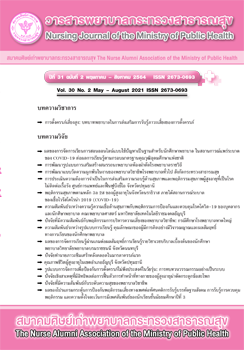Causal Factors Influencing Physical Functional Recovery of the Elderly Following Hip Surgery
Main Article Content
Abstract
Functional recovery in the elderly following hip surgery affects their quality of life. This study was conducted to examine causal factors influencing the physical functional recovery in the elderly following hip surgery over a period of 3 to 6 months, in 12 hospitals. Eight tertiary and 4 medical hospitals were included. A stratified random sampling method was used to select the sample. The sample size was calculated by using the probability proportional to size sampling (PPS) method. The number of samples was 37-41 depending on the difference in the number of surgical patients in each hospital. Samples were randomly selected by the convenience method to answer the self-administered questionnaires. Instruments used for data collection were general information questionnaires, a family caregiver support questionnaire, a self-management questionnaire, a health service system questionnaire, and a physical function recovery questionnaire. Data were analyzed using path analysis with the AMOS program. The results revealed that age, comorbidity, pain, support from family caregivers, and care models had a direct effect on self-management, indirect effect on the physical functional recovery, and explained 24 % of the variance in self-management (R2=.244, p<.001), and self-management explained 2.4% of the variance in physical functional recovery (R2=.0244, p<.001). These study findings suggest that the physical functional recovery following hip surgery in the elderly is related to many factors, with both direct and indirect effects. Although self-management had a direct effect on post-operative recovery, self-management for a healthy recovery needs to control the underlying condition, pain management, family caregiver support, and continuing health services post-discharge.
Article Details
บทความและรายงานวิจัยในวารสารพยาบาลกระทรวงสาธารณสุข เป็นความคิดเห็นของ ผู้เขียน มิใช่ของคณะผู้จัดทำ และมิใช่ความรับผิดชอบของสมาคมศิษย์เก่าพยาบาลกระทรวงสาธารณสุข ซึ่งสามารถนำไปอ้างอิงได้
References
2. Berg U, Berg M, Rolfson O, Erichsen-Anderson A. Fast-track program of elective joint replacement in hip and knee—patients’ experiences of the clinical pathway and care process. JORS.2019;14(1):1-8.
3. Suratthani Hospital. Statistics of hip surgery 2017-2019. Suratthani: Hospital;2020.
4. Adib Hajbaghery M, Abbasinia M. Quality of life of the elderly after hip fracture surgery: a case-control study. JCS.2013;2(1):53-9.
5. Paunescu F, Didilescu A, Antonescu DM. Factors that may influence the functional outcome after primary total hip arthroplasty. Clujul medical 2013;86(2):121-7.
6. Cohn MR, Cong GT, Nwachukwu BU, Patt ML, Desai P, Zambrana L, et al. Factors associated with early functional outcome after hip fracture surgery. Geriatr Orthop Surg Rehabil.2016;7(1):3-8.
7. Coulter CL, Scarvell JM, Neeman TM, Smith PN. Physiotherapist-directed rehabilitation exercises in the outpatient or home setting improve strength, gait speed and cadence after elective total hip replacement: a systematic review. Jphysiother.2013;59(4):219-26.
8. Edgren J, Salpakoski A, Sihvonen SE, Portegijs E, Kallinen M, Arkela M, et al. Effects of a home-based physical rehabilitation program on physical disability after hip fracture: a randomized controlled trial. JAMDA.2015;16(4):350.e1-7.
9. Peeters CMM, Visser E, Van de Ree CL, Gosens T, Den Oudsten BL, De Vries J. Quality of life after hip fracture in the elderly: a systematic literature review. Injury.2016;47(7):1369-82.
10. Gosch M, Hoffmann-Weltin Y, Roth T, Blauth M, Nicholas JA, Kammerlander C. Orthogeriatric co-management improves the outcome of long-term care residents with fragility fractures. Arch Orthop Trauma Surg. 2016;136(10):1403-9.
11. Gordon M, Paulsen A, Overgaard S, Garellick G, Pedersen AB, Rolfson O. Factors influencing health-related quality of life after total hip replacement-a comparison of data from the Swedish and Danish hip arthroplasty registers. BMC Nursing.2013;14(1):3-16.
12. Shyu YI, Chen MC, Wu CC, Cheng HS. Family caregivers’ needs predict functional recovery of older care recipients after hip fracture. J Adv Nurs. 2010;66(11):2450-9.
13. Ozdemir O, Tosun BU. Effects of home exercise programmes during home visits after hip replacement: a systematic review. JCPSP.2017;27(1):34-7.
14. Pastora-Bernal JM, Martín-Valero R, Barón-López FJ, Estebanez-Pérez MJ. Evidence of benefit of tele-rehabilitation after orthopedic surgery: a systematic review. J Med Internet Res.2017;19(4):1-28.
15. Brembo EA, Kapstad H, Van Dulmen S, Eide H. Role of self-efficacy and social support in short-term recovery after total hip replacement: a prospective cohort study. Health Qual Life Outcomes 2017;15(1):1-10.
16. Zhu NN, Xu PP, Lei TT, Sun T, Chan SW. Postoperative pain self-management behavior in patients who underwent total knee or hip arthroplasty. AORN.2017;105(4):355-64.
17. Hayashi K, Kobayashi K, Shimizu M, Tsuchikawa Y, Kodama A, Komori K, et al. Self-efficacy is an independent predictor for postoperative six-minute walk distance after elective open repair of abdominal aortic aneurysm. Disabil Rehabil.2017:1-5.
18. Olsson L-E, Hansson E, Ekman I. Evaluation of person-centred care after hip replacement-a controlled before and after study on the effects of fear of movement and self-efficacy compared to standard care. BMC Nursing.2016;15(1):15-53.
19. Cohen J. Statistical power analysis for the behavioral sciences. New York: Academic Press;1977.
20. Smilkstein G. The family APGAR: a proposal for a family function test and its use by physicians. JFP. 1978;6(6):1231-9.
21. Brislin RW. Back-Translation for Cross-Cultural Research. Jccp.1970;1(3):185-216.
22. Osborne RH, Elsworth GR, Whitfield K. The Health Education Impact Questionnaire (heiQ): an outcomes and evaluation measure for patient education and self-management interventions for people with chronic conditions. Patient Educ Couns.2007;66(2):192-201.
23. Gandek B. Measurement properties of the Western Ontario and McMaster Universities osteoarthritis index: a systematic review. Arthritis Care Res 2015;67(2):216-29.
24. Bernatz JT, Tueting JL, Anderson PA. Thirty-day readmission rates in orthopedics: a systematic review and meta-analysis. PLoS One.2015;10(4):1-20.
25. Stott-Eveneshen S, Sims-Gould J, McAllister M, Fleig L, Hanson H, Cook W, et al. Reflections on hip fracture recovery from older adults enrolled in a clinical trial. JGGM.2017;(3):1-8.
26. Bartlett A, Parton S, Lattuca J. Physical therapy self-management strategies for a patient with a total hip replacement and heart failure: a case report. HHCN.2018;36:304-11.
27. Avila MA, Pereira GJ, Bocchi SC. Informal caregivers of older people recovering from surgery for hip fractures caused by a fall: fall prevention. Cien & Saude Coletiva 2051;20(6):1901-7.

